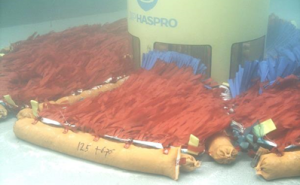...
In JIP HaSPRo we focus on three scour protection methods. First, conventional (loose) rock protection methods are considered against scour around monopile foundations or cable crossing failures. For these -relatively well understood methods- we focus on filling the gaps of available datasets. To assess these conventional protection methods we focus on all possible failure mechanisms, meaning both external and internal stability as well as flexibility of scour protections, conducting specified tests, by testing a large range of hydrodynamic conditions as well as many different rock grading designs. Furthermore, we conducted model tests to investigate all possible failure mechanisms of the conventional rock protection methods; we focused on external stability (movement of rock at or away from the scour protection), internal stability (winnowing of underlying sand through the scour protection layer) as well as flexibility (falling apron behavior) of loose rock scour protections.
Furthermore within the JIP HaSPro scope, many innovative protection methods have been tested in experimental conditions, some of them for the first time, to provide us with alternative solutions to help reduce the costs by simplifying the installation phase, facilitate monopile decommissioning and finally protect against scour, infrastructure that is situated in highly dynamic environments where extreme morphological changes and hydrodynamic conditions are expected. Such innovative methods include concrete block mattresses, gabions, artificial vegetation, ballast-filled mattresses and self-installable systems.
Lastly, we focus on eco-friendly scour protection methods. Nature-inclusive design of scour protections is aimed at increasing the potential ecological value that wind farms may add to the marine environment, by providing shelter for target species or by contributing to restoration of previously booming reefs that have degraded while subjected due to human pressures pressure, like in the North Sea. In JIP HaSPro we build an ecological framework that accounts for the existing legislation and guidelines and provides a consolidated basis for the offshore wind industry to make choices concerning all phases of nature-inclusive design (design, construction & operation and decommissioning). Furthermore, we test the hydraulic stability and overall performance of scour protections that include ecological elements like shells and reefballs.
Sponsors
Two TKI's:
TKI-WOZ
TKI-DT
21 participantsThis joint industry project is supported by two consortia for knowledge and innovation (Topconsortia voor Kennis en Innovatie), namely TKI-Wind op Zee and TKI-Deltatechnologie. It has 21 participants from the full spectrum of offshore wind industry including contractors, utilities, engineering firms, suppliers, a certifying body and a research institute.
Main deliverables
The deliverables of the JIP HaSPro include new design formulae, an online digital handbook of best practices and an Engineering Software Tool engineering software tool for the considered scour protection methods in this Joint Industry Project. Moreover, a large database with model test results, containing 3D-data of scour protection layouts and deformation patterns, as well as a 3D-viewer to visualize these results are part of the deliverables of this JIP. Results will be confidential for a certain period which typically is 2 years.
Timeline
JIP HaSPro was initiated in 1-9-2016 and will be in progress until 1-9-2020. Results will be confidential for a certain period which typically is 2 years.


